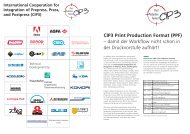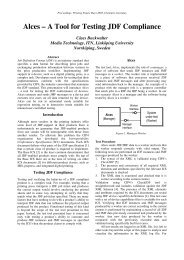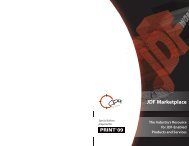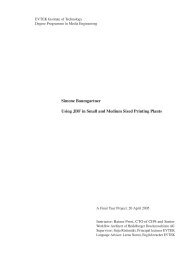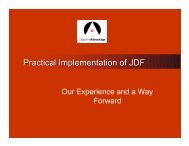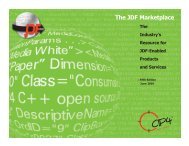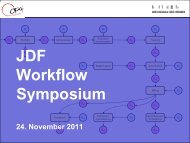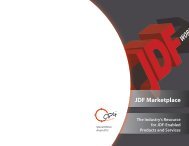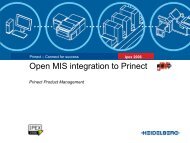Create successful ePaper yourself
Turn your PDF publications into a flip-book with our unique Google optimized e-Paper software.
Master Project at Nada Evelina Thunell<br />
so widely implemented yet is no longer a big problem for the MIS vendors, because of<br />
the cross-linking architecture Euprima developed. <strong>The</strong>y also developed a target<br />
suggestion regarding JMF. In the summer 2003 the IRD [20] will start a project, which<br />
computes the economy of cross-linking solutions.<br />
3.4.4 Digital Printing<br />
A Variable Digital Printing (VDP) job comprises the definition of many customized<br />
sets of pages where every set can be used to fill a series of sheets in a finished booklet.<br />
<strong>The</strong> page content of one of these booklets is customized to appeal to the targeted end<br />
recipient. <strong>The</strong>se customized pieces can for example vary in number of pages, page<br />
content and utilization of media. <strong>The</strong> workflow process requirements are evidently<br />
relatively complex where both content and finishing differs. [21]<br />
Tim Donahue [21] explains that there are many VDP oriented Page Description<br />
Language (PDL) formats today, of which most are proprietary. <strong>The</strong> past few years it<br />
was realized that the market growth in the area of digital printing was not advancing.<br />
<strong>The</strong> reason was thought to be the lack of portability and interoperability among these<br />
formats. Another reason was the difficulty for commercial printers to enter into VDP<br />
because the current tools require the printer to be involved in all aspects of a job<br />
authoring and also the print production. If these two aspects could be separated, growth<br />
could be gained in the digital printing area. Authoring involves both database expertise<br />
and graphic design expertise.<br />
<strong>The</strong> Print On Demand initiative (PODi), a consortium of vendors, attempted to create a<br />
non-proprietary VDP PDL, an XML based page layout format, known as Personalized<br />
Print Markup Language (PPML). PPML is a layout technology designed to contain a<br />
broad range of VDP RIP implementations with features that enable its support of<br />
proprietary solutions.<br />
Another standard developed in 2002, PPML/VDX, use chosen subsets of PPML for<br />
specifying the page layout, PDF for specifying page content elements and <strong>JDF</strong> for<br />
specifying the product intent. PPML, used in this way, is intended to meet the strictest<br />
requirements of portability, interoperability and device independence in order to<br />
separate the authoring and the print production. [21]<br />
<strong>The</strong> PPML data can be equipped with elements called TICKET_REF. <strong>The</strong>se reference<br />
elements can refer to device parameter resources or to product intent resources. This<br />
means that the DPL data refers to parts of the job ticket instead of the job ticket<br />
referring to various documents and pages defined in the PDL data. This leads to<br />
relatively complex processing requirements where many combinations of device<br />
processing states may be established throughout the processing.<br />
In <strong>JDF</strong> 1.1 the Digital Printing working group defined ResourceUpdate resources.<br />
<strong>The</strong>se provide a mechanism that allows the variable data PDL to refer to individual<br />
resources or partitions of resources from within the PDL context. Tim Donahue [21]<br />
says that it is more or less a data driven process finite state machine approach. <strong>The</strong><br />
problem with using this approach, ResourceUpdate for process control in a VDP<br />
production workflow, is that it can get very complex. Another problem is that it is not<br />
clear how imposition printing can be accomplished.<br />
<strong>JDF</strong> does not make digital printing easier but it provides a more unified way for<br />
producers and consumers to achieve commonality in the expression of product intent<br />
and process control. <strong>The</strong> most complex aspect is the authoring of the VDP job and it<br />
requires cooperation between client, designer, IT expert and printer. Tim Donahue [21]<br />
says that it is likely that <strong>JDF</strong> will be extended to define this coordination. <strong>JDF</strong> will help<br />
the users to focus on the requirements of the job instead of learning new vendor<br />
proprietary tools.<br />
25




